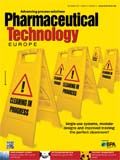Choosing Cleanroom Clothing
Pharmaceutical Technology Europe
PTE quizzes Jaime Cassar, cleanroom category manager at Kimberly-Clark Professional Europe, about the importance of sterile garments for cleanroom environments.
How important is the selection of sterile cleanroom clothing?
People are the biggest source of potential contamination to a sterile cleanroom so sterile clothing is crucial. As a basic requirement, sterile clothing must help maintain a cleanroom’s cleanliness while people are working in the area, by ensuring that particle and microbiological levels are kept below the limits for the chosen grade of area, as set in the EU Guidelines to GMP for Sterile Manufacturing. At first glance, this may seem quite straightforward. However, sterile clothing has a direct impact on both contamination control and productivity of a sterile manufacturing process, so several factors beyond the basic requirement need to be considered when selecting clothing.

Jaime Cassar. Cleanroom category manager at Kimberly-Clark Professional Europe
Sterile clothing should be selected with continuous improvement in mind, with choices made on the basis of either better controlling or eliminating variables that impact contamination control and productivity. Any continuous improvement delivered by sterile clothing will help to improve yields, and protect quality —in this way sterile clothing selection can play an important part of a Quality by Design approach to a sterile manufacturing process. The materials, design features, manufacturing, cleaning, packaging, sterilisation, specification, quality controls, documentation and certification of sterile clothing are all attributes that affect how cleanroom clothing interact with sterile manufacturing processes.
How can the protection provided by sterile clothing help to create process improvements?
The cleanliness of sterile clothing is important to consider in order to prevent the clothing from itself becoming a source of contamination. For example, sterile gloves that have been washed in di-ionised water, cleanroom packed, sterile validated and specified for low endotoxin levels can help lower the risk of particle, microbiological and endotoxin contamination. Sterile apparel that is laundered, cleanroom packed in individual vacuum packaging, double-bagged and provided with periodic sterile validation will also contribute to lower contamination risks. Sterile gloves made from synthetic materials are beneficial because they can eliminate the risk of contaminating the final product with rubber latex proteins, which can be a problem for patients with latex allergies.
Another crucial point is the barrier performance of the clothing. Continuous improvement can come from better control or elimination of variability in attributes that impact barrier performance. For example, disposable apparel eliminates the risk of variability in filtration efficiency and material strength that may come from re-wearing, re-washing and re-sterilising apparel many times and over a long period of time. Sterile apparel made from stronger materials and sterile gloves with a higher quality film formation will be more resistant to breakage and are more likely to be free from any pinhole type defects.
As well as protecting the process from contamination, sterile clothing should also protect the wearer from the health and safety risks presented by chemicals and APIs. Sterile gloves tested to show longer resistance times to permeation by cytotoxic chemicals and sterile clothing certified to provide protection against chemical splashes can contribute to better protection for the wearer. In Europe, sterile gloves and apparel should be Category III certified under the personal protective equipment (PPE) directive 89/686/EEC, if there is risk of exposure to chemicals and APIs. There are also other ways to protect wearers from health and safety risks. For example, sterile clothing that is biocompatible can mitigate the risk of the clothing causing irritation to the wearer, and sterile gloves that are free from natural rubber latex will eliminate the risk of latex allergies.
How can sterile clothing help to protect the clean manufacturing process?
Better comfort will help workers to be more productive and reduce the number of mistakes that can lead to contamination risks. Some examples of improving comfort are using sterile gloves made from more flexible materials; sterile apparel made from materials with a breathable barrier and a cloth-like feel; sterile masks that use comfortable materials for the inner facing layer and attachments, and sterile masks with a larger breathing chamber. A good fit is also important because it reduces contamination risk; for example, sterile clothing that is too big may accidently touch surfaces while clothing that is too small may break during use. Improving fit can be achieved by using sterile clothing that is available in a wider range of sizes, and using sterile clothing that is individually packed so the individual can choose different sizes for different items to better match their proportions. Sterile clothing that comes with design features to encourage a more secure fit, such as apparel that is better shaped to match the human body shape, apparel with an elastic waistband, and sterile masks that are shaped to the contours of the face, is also beneficial for the user.
With regards to the ease of the gowning process, it’s worth considering design features, such as those that prevent clothing from touching the floor or from being touched on the outside during gowning. The choice of material can play a part in ease of use; for instance, gloves made of more elastic materials are easier to put on and double don. Integrated clothing, such as clothing that features an integrated hood and mask, can also make the gowning process simpler and easier.
Hygiene is also an important factor to consider. Human hygiene can be improved (and thus contamination risks reduced) by using disposable clothing or by selecting sterile clothing that reduces the amount of sweat build-up. In addition, it’s important to ensure that people do not wear the same items of sterile clothing for too long a period of time. If reusable apparel is used, it’s important that they are only ever used by the same person.
What other factors should be considered when selecting sterile clothing?
The types of considerations and their relative level of importance can vary amongst the different types of activities that are carried out in a sterile manufacturing process. The considerations I have described within Protection, Comfort and Ease of Use are not exhaustive. One must consider any other ways that sterile clothing may interact with a specific process or application. For example, some tasks in the sterile cleanroom require a higher level of precision to perform effectively, and therefore gloves made with materials that offer a higher level of tactile sensitivity and dexterity can help to improve productivity of this task.
There are many stakeholders in the sterile garment selection process, for example Finished Product Quality control, Environmental Quality control, Production Management, Health and Safety, Procurement and Waste Disposal. Though the primary objective of any sterile garment selections should be to better control or eliminate variability to improve contamination control and productivity, there are other factors to consider, such as the time, resources and cost of implementing an improved sterile clothing system. The manufacturer of the sterile clothing can support all decision makers involved in the selection process.
What challenges are involved when validating new sterile clothing?
In general, if a supplier’s equipment may possibly impact the quality of a finished product from the client then the equipment must be integrated with the client’s quality system.
With regards to sterile clothing, the first step before any validation process is to ensure that the quality processes of the sterile manufacturer are compatible with the requirements for quality systems dictated by their internal policy and regulatory bodies such as the FDA or EMA. Sterile clothing made at manufacturing sites which are compliant with FDA CFR 21 part 820, ISO13485 certified and/or ISO9001 certified may be easier to integrate in terms of quality systems requirements. Quality control documentation form the sterile manufacturer can also help, for example certificates of conformance to specification, certificates of irradiation, periodic sterile validation audits and lot testing of performance characteristics. Because sterile clothing is an integral part of sterile manufacturing process equipment, any modifications to sterile clothing that could impact the output quality of this process.
Validation of sterile clothing is done under a change-control procedure. Change-control documentation has to be prepared with the collaboration of a change-control team, which may comprise stakeholders from many departments including finished product quality control, environmental quality control, production management and the health and safety executive. Successful preparation for a change control proposal meeting will provide a clear understanding of the project objectives, and demonstrate why the project addresses continuous improvement that could result in either better control or the elimination of variables that impact contamination control and productivity.
A change control project requires a validation study, which includes testing to demonstrate that the sterile clothing system has no possible detrimental effects on the quality of their finished product. Validation protocols have to be clear and complete regarding the risk analysis and should confirm what tests will be used to validate the clothing.
The validation protocols will also cover the review of existing documentation, including standard operating procedures (SOPs) and specifications that are directly affected by the sterile clothing system. Any additional documentation that would be required along with the validation study, such as the gowning procedure, would be provided to the team executing the change-control project under a temporary status for final approval. Any training related to validation protocols and temporary documents for use of the sterile clothing system must be given to the team.
Change-control projects and validation necessitate a lot of paper work and substantial time from the quality and production teams. A successful change control project starts by clearly defining the appropriate testing, documentation and training that is required to execute the project. This can help make all steps and timings clear for everyone at the outset and make the change control process more efficient. Ultimately, this will lead to a quicker realisation of contamination control and productivity benefits for the enterprise.

Drug Solutions Podcast: A Closer Look at mRNA in Oncology and Vaccines
April 30th 2024In this episode fo the Drug Solutions Podcast, etherna’s vice-president of Technology and Innovation, Stefaan De Koker, discusses the merits and challenges of using mRNA as the foundation for therapeutics in oncology as well as for vaccines.